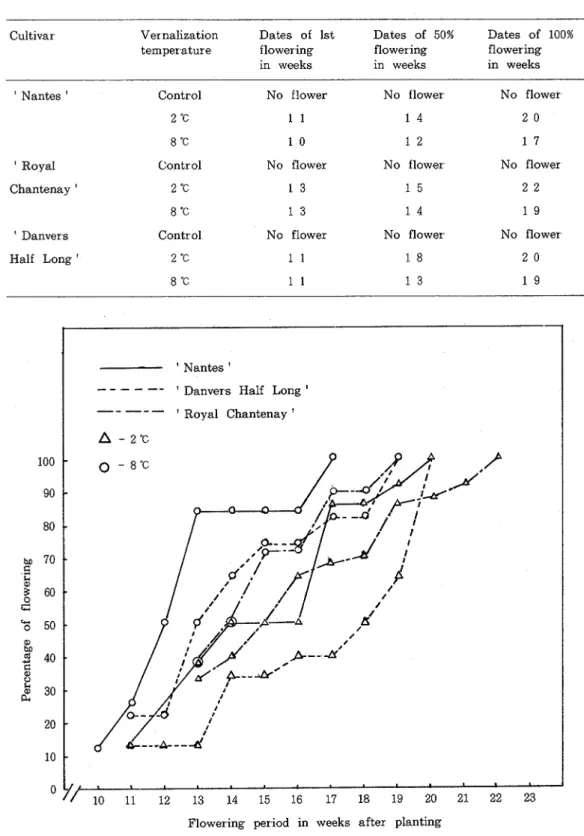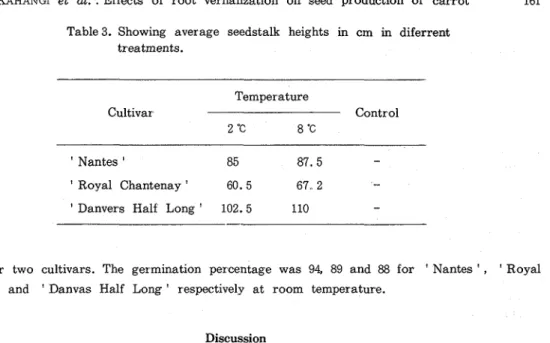Tech. Bull. Fac. Agr. Kagawa Univ., Vo1. 39, No. 2, 157-162, 1988
THE EFFECTS OF ROOT VERNALIZATION ON SEED PRODUCTION
OF CARROT
(Daucus carota L.) AT J U J A , KENYA
Murugi KAHANGI-',
Yukihiro
FUJIME
,
Mureithi
MUGAMBI* and Jane KIGOTHO"Summary
Artificial vernalization (2"C, 8°C 8 weeks) of carrot roots resulted in flower and seed production a t Juja (1500m), Kenya where natural flowering could not occur due t o lack of chilling temper- atur es.
'
Nantes'
and'
Danvas Half Long'
produced significantly higher seed yield than'
Royal Chantenay'
a t 8°C vernalization.Both
'
Danvas'
and'
Royal Chantenay ' yielded significantly less than'
Nantes'
a t 2°C vernal- ization.Low yield observed in
'
Royal Chantenay ' a t both temperatures were due t o production of sessile flower stalks probably caused by high post vernalization temperatures.* = 7 O 9 = 9 v (&&1500m) ~ ~ I ' b E ~ % l t l ~ ~ ~ % ? f c l & E i t : K T , @ T Q f c & , $%0%4+7; -C= - / ~ . / I X @ & % ~ L T B ~ ~ LahL, = - / 2 - / O ' t - / f ' , L ~ L ~ , ' b - / / : x / . - 7 ~ - / 7 ' , ' ~ 4 ? / ~ 4 * - / 5 ; Z ' 4 ) 3 & ! 1 @O@?LRL\T%~L~!LW! ( 2", 8°C
.
8 B P d ) %$?5
4 t : K 1 9 , l%Ek%%&%8Lf:oJ & B & E 8 ' C T , ' Y - / f ' 2 ' f . / / : - x ~ ~ - 7 ~ - / ? ' i t ' ~ 4 ? ) ~ 4 t - / 7 . i : ' 1 9 , d S 4 E B I t t % k ~
4 D n
L f ~ oa ~ g t f ~ ~ ~ c
-c,
'a
-/,:A 't:
' ~ 4 ~ 1+- / s +
~ 4i: '12 ' t Y T 'a
e ,
t ' r & E m a m : t ~ a / L ' L f : ~rnEE-C,
' s 4 ? / b 4*
-/?=.i: I t ~ l L & W ! ~ ~ ~ ~ O f c & % @ ~ E Z ~ ~ % & S h , ? O % E , @ ' r 4 & 3 t t @ / L ' L f i k S k b h Q oIntroduction
Carrot is the fourth most populary consumed vegetable in Kenya. Like other temperate vegetables,
158 Tech. Bull. Fac.. Agr . Kagawa Univ., Vo1. 39, No.. 2 (1988)
carrot does not flower naturally in the low altitudes of Kenya. The country has therefore t o depend on importation of its seed.
Research has been going on t o test whether Kenyan highlands could be utilized for carrot seed production. Experiments conducted in Molo (2554m) and Njambini (2300m) showed that although these areas have the chilling temperatures required for carrot seed production, high rainfull and low temperatures throughout the year render them unsuitable for seed production (5)
Early workers showed that vernalization of carrot roots a t 4.8 t o 10°C for 15-60 days resulted in 100% seedstalk f ~ r m a t i o n " ' ~ ' ~ ? Other workers reported poor seedstalk for mation when vernalized roots were grown a t high post vernalization
temperature^(^'^)
.
This work was carried out t o investigate whether artificial vernalization could result in flowering and seed production a t Juja and whether high post vernalization temperatures a t Juja would cause poor flower stalks formation. Three cultivars, 'Nantes', 'Danvers Half Long' and 'Royal Chantenay' were compared a t two different vernalization temperatures, 2°C and 8°C plus control. The experiment was carried out for one season in 1985.
Materials and Methods
Certified seeds of the three cultivars 'Nantes', 'Royal Chantenay' and ' Danvers Half Long
'
were bought from a seed Company in Kenya which had imported them from Europe. All the three cultivars were open pollinatedCarrot roots were raised following the recommended procedure for market roots. Roots t o be vernalized were harvested fir s t and handled a s follows :
Thirty-six medium sized roots (4 centimeters diameter) from each cultivars were selected for 2°C and 8°C vernalization treatment. These were washed, trimmed t o leave 4 cm leaves and then treated with a fungicide. The roots of each treatment was then placed in a polythene bag with vermerculite and stored in respective cold rooms for eight weeks.
After the eight week vernalization period roots for the control were harvested and prepared a s above. Roots for all treatments were again treated with a fungicide before planting in a complete randomized design with 2 replicates in the field.
Planting holes were dug a t a spacing of 30 cm x 60 cm. Double superphosphate (46% P 2 0 5 ) was added t o the planting hole a t the rate of 6 grams per hole. The roots were put in the holes and covered firmly with the soil ensuring that their crowns were just in level with the soil.
Results
Vernalization temperatures a t 2°C and 8°C induced 100% flowering in all the three carrot cultivars. The control did not flower. Table 1 and figure 2 show the time taken in weeks after planting for the first 50% and 100% flowering to occur in all the treatments.
'
Nantes'
vernalized a t 8 C was the first to flower and t o reach 100% flowering. Eight degrees vernalization temperature tended to cause a faster flowering rate in all the cultivars (Table 1 and Fig. 2). 'Nantes' and 'Danvas Half Long ' had significantly higher seed yields than'
Royal Chantenay'
a t vernalization of 8°C. Both ' Danvas Half Long'
and'
Royal Chantenay'
yielded significantly less seed than'
Nantes'
a t 2°C vernalization temperature. 'Royal Chantenay' yielded poorly a t both temperatures.'
Danvas Half Long'
yielded significantly higher seed yield a t 8°C than a t 2°C (Table2 and Fig. 2).'Danvers Half Long ' had the highest mean seedstalk height whereas
'
Royal Chantenay'
had the lowest (Table 3). A number of sessile seedstalk were observed in'
Royal Chantenay'
and notKAHANGI et al. : Effects of root vernalization on seed production of carrot 159
Table 1. Showing flowering dates in weeks after planting in all treatments.
Cultivar Vernalization Dates of 1st Dates of 50% Dates of 100%
temperature flowering flowering flowering
in weeks in weeks in weeks
'
Nantes'
Contr 01 No flower No flower No flower2 "C 1 1 1 4 2 0
8 "C 1 0 1 2 1 7
'
Royal Contr 01 No flower No flower No flowerChantenay
'
2 "C 1 3 1 5 2 28 "C 1 3 1 4 1 9
'
Danver s Contr 01 No flower No flower No flowerHalf Long
'
2 "C 1 1 1 8 2 08 "C 1 1 1 3 1 9
-
Fig. 1, Effect of two vernalization temperatures on flowering of three cultivars of carrots..
Tech. Bull. Fac. Agr. Kagawa Univ., Vo1.39, No. 2 (1988) Table 2. Average seed yield in grams in three carrot
cultivars vernalized a t 2°C and 8°C
Temperature Cultivar Contr 01 2 "C 8 "C
'
Nantes'
118 66 ac* 199 44 a-
' R o y a l Chantenay' 22.7 b 38 7 b -'
Danvers Half 8 9 b 159 82 a - Long'
*
~ e a n separation by Duncan's multiple range test, 5% level5
m 1502
b o o
0'
Nantes'
'
Royal Chantenay'
'
Danvers Half Long'
Fig. 2. Effect of two vernalization temperatures on seed yields ofKAHANGI et al. : Effects of root vernalization o n seed production of carrot 161 Table 3. Showing average seedstalk heights in cm in diferrent
treatments. Temperature Cultivar Contr 01 2 "C 8 "C
'
Nantes'
85 87. 5 -'
Royal Chantenay ' 60.5 67. 2-
'
Danvers Half Long'
102.5 110 -in the other two cultivars. The germination percentage was 94, 89 and 88 for
'
Nantes' , '
Royal Chantenay'
and'
Danvas Half Long'
respectively a t room temperature.Discussion
In this work all the three cultivars attained 100% flowering a s a result of artificial vernalization of their roots a t 2°C and 8°C for eight weeks. The control did not flower. These results seems to be a t variance with Hiller and Kelly ( 4 ) who reported a reduced flowering percentage when vernal-
ized carrot roots were grown in a greenhouse a t post vernalization temperatures of 21/27 and 27/32 ("C). In this work we got 100% flowering despite that the maximum monthly temperatures during the period the experiment was in the field were above 21°C (Table 4) However the low night temperatures could have contributed to increased flowering
.
Table 4.. Temperature d a t a in 1985 during the time the experiment was in the field.
Month Max. temp. , "C Max. temp., "C
March 25.5 April 24. 5 May 23. 5 June 24.1 July 22.1 August 21.7
The three cultivars showed significant differences in seed yield ' Nantes
'
was the best yielder (2)while the 'Royal Chantenay' was the poorest Hiller and ~ e l l y ' ~ ) and Eisa and Wallace reported that high post vernalization temperatures (21/27 and 27/32) caused sessile flower (flower with no seedstalk) formation in 'Royal Chantenay' This phenomenon was observed in this work and it explpins the low seed yield observed in 'Royal Chantenay'
.
Stecklings vernalized a t 8°C gave significantly higher yield than those vernalized a t 2°C. Though we could not get any literature to support this phenomenon it was observed that roots vernalized a t 2'C produced weak and few seedstalks per plant with limited number of tertiary and secondary
162 Tech. Bull. Fac. Agr. Kagawa Univ., Vo1.39, No. 2 (1988) umbels.
Some root r o t was observed in this experiment and could interfere with seed production in the future.
Literature Cited 1. DICKSON, M.H and C.E. PETERSON.: Hastening
greenhouse seed production for carrot breed- ing, Proc. Ame. Soc. Hort. Sci.
,
71, 412-415(1958).
2. EISA, H,M. and D.H WALLACE :Factors influ- encing petaloidy expression in the carrot (Da- ucus carota L.), J.Amerscan Soc. Hort. Sci.
,
94 647-649 (1969).
3. HAWTHORN, L R . : Cultural studies on carrot stecklings in relation t o seed production, U.S. Dept. Agr. Circ. 877 (1951).
4. HILLER, L.K and W.C. KELLY : The effect of post-vernalization temperature on seedstalk elongation and flowering in carrots, J. Amer i- can Soc. Hort. Sci. 104 (2), 253-257 (1979). 5. KAHANGI, E.M. : Carrot seed production in
Molo and Njambini, Annual Report Horticul- ture Reasearch Station, Thika Kenya (1979). 6. SAKR, S, and H.C THOMPSON.: Effects of temperature and photoperiod o n seedstalk de- velopment in carrot, Proc. Amer. Soc. Hort. Scz, 41, 343-346 (1942)


